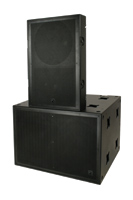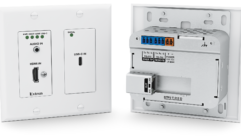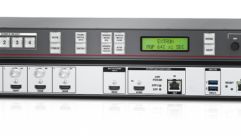

Tannoy VQ Net 60 and VNet 218DR
May 6, 2010 12:00 PM,
By John McJunkin
A loudspeaker and subwoofer combination that yields a four-way system for sound-reinforcement applications.
Tannoy is known the world over for its excellent studio monitors. There aren’t many studios in the world that haven’t had a pair or three at one time or another. Tannoy has turned its attention to creating sound-reinforcement loudspeakers, and among the products of its labors is the VQ Net series of active, network-linked loudspeakers with digital signal processing. These loudspeakers are intended for use in arrays or individually, and provide all the obvious benefits that self-powered loud¬speakers bring. As a live sound engineer who frequently requires powerful, high-fidelity loudspeakers that I can easily transport and quickly configure, I was excited to get my hands on these. Additionally, I have always liked Tannoy’s studio monitors, so I found myself very curious as to whether the firm could successfully translate the quality of its fine studio loudspeakers to the sound-reinforcement domain.
I evaluated a pair of VQ Net 60 loudspeakers along with a pair of VNet 218DR subwoofers, the combination of which yields a de facto four-way system: the VQ Net 60 loudspeakers are a three-way system, and the VNet 218DRs fill in the low end. Tannoy touts this loudspeaker series as a “line-array killer,” and the company is not the only loudspeaker producer in the world to extol the virtues of point-source loudspeakers. It’s unlikely that the debate over whether point-source loudspeakers can be used interchangeably with line arrays will be resolved anytime soon, despite the smart people who argue each position, but it’s clear that there are appropriate applications for both topologies. From a practical standpoint, I’d rather roll VNet loudspeakers in on their dollar boards than fly arrays from a truss, particularly for applications in small to mid-sized venues that don’t require huge amounts of SPL. On the other hand, the VQ Net series are actually capable of producing a pretty substantial amount of SPL; they’re rated at 138dB SPL continuous. And I discovered these loudspeakers to be simple to set up—although I would not recommend making this process a one-person project unless that person is a body-builder. The recommended orientation is to place the VQ Net 60 atop the subwoofer, and the heft of these loudspeakers definitely does not make for a safe one-person job.
I was otherwise pleased with the mechanisms intended to make transport and rigging easier. The dollar boards included with the VQ Net 60s are welcome, and cleverly include attached rigging hardware. The subwoofers are not intended for flying, but the VQ Net 60s can be flown with eyebolts and brackets, and they can be linked and arrayed with additional hardware. VQ Net MB and VQ Net 85DF cabinets can be combined for additional pattern control. Every loudspeaker has at least two handholds on each of its four sides. I was able to tilt a subwoofer from its performance orientation up onto its wheels by myself as a result of the placement of the handholds and the center of gravity of the cabinet. The other clever convention I discovered is the plates that cover each subwoofer’s array of connection ports. During transport and storage, these plates pop right into place with magnets to protect connections and controls.
Wiring is simple as well. AC power is provided via Speakon connectors, and audio is introduced via standard XLR inputs. These loudspeakers are telemetrically monitored and controlled via Tannoy’s network software, and these connections are made via RJ-45 Ethernet ports. I like that the network can be configured in a daisy-chain, a star network, or any combination of both topologies. With the assistance of an engineer acquaintance of mine, I was able to get the system up and running in less than half an hour, and time could be shaved from that performance with some repetition. One issue that is a little troublesome to me is that audio will not pass through the loudspeakers unless they are connected to the network and unmuted with the included software. Any computer- or network-oriented snags can be a roadblock to simply getting signal to play through the loudspeakers. It may be the case that the loudspeaker simply stores the previous mute configuration, and it’s possible to leave the loudspeakers unmuted, but I’d rather not have the potential for the loudspeakers to have been left in muted mode upon last power-down. I hope that will be addressed in future revisions.
The VQ Net 60 features a semihorn-loaded topology with two 12in. LF drivers on angle with each other, and a conical horn loaded with concentric MF and HF drivers, which provides a single coherent wavefront emanating from the throat. The MF driver has a 3.5in. coil and covers 400Hz to 7kHz, and the HF driver has a 2in. diaphragm and covers 7kHz to 22kHz. I like the fact that Tannoy put the crossover points at frequencies that are not in the middle of the human vocal range. The 60-degree conical dispersion of the MF and HF horn structure is efficient, with a directivity factor of 21.2. As I walked around to subjectively assess this directivity, I was truly impressed. The signal drops off precipitously just a few steps beyond the edge of the dispersion pattern. This means that in typical applications in which these loudspeakers are stacked on stage, performers and public speakers hear very little of FOH, even when the system is producing substantial SPL.
Tannoy VQ Net 60 and VNet 218DR
May 6, 2010 12:00 PM,
By John McJunkin
A loudspeaker and subwoofer combination that yields a four-way system for sound-reinforcement applications.
Having established that it’s plausible for a very small crew (even just two people) to transport and set up these loudspeakers, the remaining question is sound quality. For lack of a less hyperbolic term, they sound stunning. I listened to a broad array of sources, and I was frankly blown away with the quality of the reproduction. The low end was full but not tubby; it was also very tight. Mids were clean and not the least bit harsh. Highs were extremely realistic and airy, with no audible brittleness, even at high SPLs. I test-drove the system in a large parking lot, and deliberately evaluated the subjective quality of the output at low SPL. Every element of the mix was clear at low SPLs, even at substantial distances from the loudspeakers. One subjective test I like to leverage is to determine if the loudspeakers have the resolution to reveal the inadequacies of 128kbps MP3 resolution, which these loudspeakers easily accomplished. The digital artifacts of low-resolution MP3 compression were very much evident listening to these loudspeakers. The Analog Devices Sharc DSP operates at 96kHz/24-bit resolution, and it sounds great. The EQs and filters are useful, as is the delay. The internal D-class amplifiers are matched with the drivers, and they sound excellent. The response to my initial question as to whether Tannoy could possibly translate the quality of its studio monitors to sound-reinforcement loudspeakers is absolutely yes.
Related Links

NAMM, the International Music Products Association, returned to Anaheim, Calif., from Jan. 14 to 17 for its 2010 winter show to an uncertain market…

You can tune a guitar or a radio, but you can’t tune a room. The knob is just too darn big! Nonetheless, the term “tuning the room” has been adopted to describe the tools and techniques used to neutralize a listening space and its installed loudspeaker system…

Technology Showcase: Line-array Loudspeakers
The field has become quite competitive in the area of line-array loudspeakers…
I’ll go out on a limb and say that these are among the very best point-source sound-reinforcement loudspeakers I’ve ever heard. They’re easy to set up (if a little on the large and heavy side), and they feature useful network telemetry and DSP control. The bang for the buck is tremendous here. Any contractor who frequently needs high fidelity and high SPL on a portable basis should seriously consider the Tannoy VQ Net line.
John McJunkin is the principal of Avalon Podcasting in Chandler, Ariz. He has consulted in the development of studios and installations, and he provides high-quality podcast-production services.
Product Summary
- Company: Tannoy
www.tannoy.com - Product: VQ Net 60 and VNet 218DR
- Pros: Exceptional fidelity, high SPL, clever transport and rigging, excellent pattern control.
- Cons: No audio without network, not movable by one person.
- Applications: Portable or install uses in small to mid-sized venues.
- Price: $27,156 (system as evaluated); $7,583 (VQ Net 60, each); $5,995
(VNet 218 DR, each)
Specifications
VQ Net 60
- Frequency response: 115Hz-23kHz (-3dB)
- Dispersion: 60 degrees conical (-6dB)
- Maximum SPL: LF: 134dB avg. (140dB peak); MF/HF: 138dB avg. (144dB peak)
- Damping factor: 120 (ref. 8Ω)
- Distortion: <0.05% @ 1kHz, -3dB output
- Input impedance: 5.6kΩ unbalanced, 11.2kΩ balanced
- Amplifier output: LF: 800W; MF/HF: 800W (limited to 400W)
- Dimensions: 36.42”x”24.41”x”19.76” (HxWxD)
- Weight: 176lbs.
VNet 218 DR
- Frequency response: 31Hz-600Hz
- Maximum SPL: 137dB avg. (143dB peak)
- Damping factor: 120 (ref. 8Ω)
- Distortion: <0.05% @ 1kHz, -3dB output
- Input impedance: 5.6kΩ unbalanced, 11.2kΩ balanced
- Amplifier output: 2500W program
- Enclosure volume: 130 gallons
- Dimensions: 27.56”x41.34”x33.46” (HxWxD)
- Weight: 232lbs.










